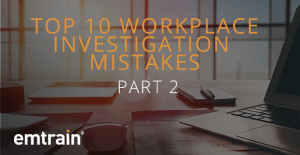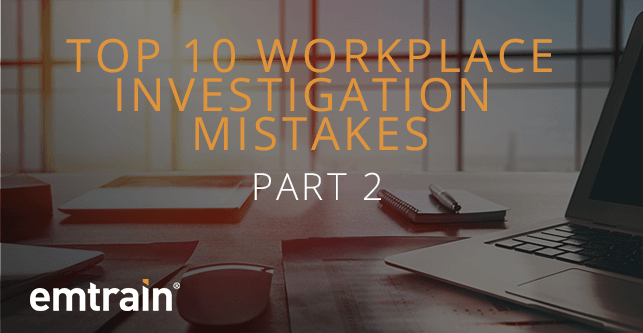In part one of this two-part series, we covered five of the most common workplace investigation mistakes that employers make, including poor complaint mechanisms, ignoring employee complaints, failing to adequately plan an investigation, and failing to be objective while investigating employees. In part two, we will review five additional common—and costly—mistakes.
As companies navigate the complexities of maintaining a fair and respectful workplace, the importance of thorough and effective investigations has never been more crucial. With increasing scrutiny on workplace practices due to recent high-profile cases and a greater emphasis on corporate accountability, employers must ensure that their investigation processes are not only compliant with legal standards but also uphold the integrity and trust within their organizations. Properly addressing complaints and conducting meticulous investigations can help prevent potential legal issues and foster a positive work environment.

Failure to Conduct Additional Investigative Work
Anyone who has conducted a few workplace investigations quickly learns that in addition to conducting interviews, you should, at a minimum, request, review, and analyze personnel documents and policies. However, depending on the nature of the allegations, there is often a need to do more. This part of the investigation often requires resourcefulness on the part of the investigator.
In many instances, the investigator may find it helpful to visit the work site or another key location. I once worked on an investigation that involved allegations of sexual harassment that had allegedly occurred in the manager’s office at a fast food restaurant. The complainant described a typical office with a desk and door where the manager performed all of his paperwork.
She described behavior that would have occurred in a typical office with the door closed. I visited the site and discovered that the manager had merely converted a broom closet into an “office.” They had removed the door and installed a shelf to hold a computer and some files.
Although this information would have come out during interviews, the fact that I saw the work area myself made my conclusions that much stronger in terms of my ability to explain them in my report.
Failure to Reach a Conclusion
Perhaps the most common mistake investigators make when conducting investigations is that they fail to reach well-reasoned conclusions. Investigators often rely on conflicting accounts to justify their inability to determine whether they have substantiated the allegations. In the vast majority of cases, an investigator should be able to review and analyze all evidence, make credibility determinations, determine parties’ motives, and reach findings and conclusions.
To reach a decision, investigators will need to rely on the evidence itself and ask: Does the evidence (including information obtained from witnesses or documents, especially those written in real time) corroborate or contradict the facts presented by the complainant? Does this information in some way bolster or refute the claims made?
In a claim involving a relationship between two parties where both parties deny the relationship, you might want to check emails, cell phone records (showing calls and text messages), calendars, or expense reports, among other documents.
I have participated in numerous investigations where both parties denied being in a romantic relationship. However, the records showed they communicated far more often than expected between a boss and a subordinate. These communications occurred during unusual hours, such as 2:00 a.m. and on weekends, and their calendars showed overlapping non-business events. In that scenario, clear credibility issues existed.
Perhaps more importantly, their story did not make sense and was not inherently believable. Although the investigation did not involve eyewitness testimony related to the allegations, the circumstantial evidence was very strong and justified reaching a clear-cut conclusion.
Reaching Legal Conclusions During a Workplace Investigation
A workplace investigation calls for factual conclusions. During an investigation, the investigator attempts to determine whether the evidence presented sufficiently substantiates the allegations, meeting a “more probable than not” standard of proof. Sometimes, investigators may also opine on whether the evidence indicates that there has been a policy violation. If wrongdoing is found, the severity of discipline or other remedial measures that need to be taken will be dictated by the level of wrongdoing.
What an investigator should avoid is reaching legal conclusions. Even if an employee has alleged “sexual harassment” or “discrimination,” for example, the job of the investigator is to determine whether there are facts that support the behavior alleged. Whether the facts rise to a level of unlawful behavior proscribed by law is an inaccurate standard for a few reasons.
First, an employer might decide not to take remedial action because the behavior is not illegal. But if an employer waits for the behavior to rise to this level, it is missing the point, both from a legal and business perspective. The goal of a workplace investigation should be to resolve behavioral issues before they become unlawful.
Another reason that reaching a legal conclusion can be problematic is that an investigation typically lacks many of the elements present in more drawn-out litigation, which typically involves collecting information to determine whether the behavior is unlawful.
Finally, a decision-maker could later review this type of conclusion, which indicates whether the facts suggest lawful or unlawful behavior. For example, a jury that reads an investigation report that concludes or indicates that the behavior was unlawful is more likely to find in the plaintiff’s favor.
Failure to Draft a Detailed Report on the Investigation
In many instances, an investigator will perform a fair and thorough investigation but will fail to put his or her analysis and conclusions into a formal report. The type of report needed will be case-specific. Sometimes a short executive summary will suffice. At other times the investigator will opt for a brief report and attach summaries of interviews. In many instances, however, it is necessary to draft a full and detailed report.
A full, detailed report should summarize the relevant facts based on the information obtained from interviews and documents (or other investigatory work) and should include a detailed analysis and conclusion section. This section should include credibility determinations, should outline the reasons for reaching a particular decision, and should clearly state the investigator’s conclusion or finding with regard to each allegation.
The most common misstep I see is the failure to draft a report when the disciplinary action taken is severe. If an employee is going to be discharged for wrongful behavior or for violating a company policy, providing a report that outlines the details of the investigation and the reasons for the findings is the most fair and appropriate action.
Failure to Close out a Workplace Investigation
A mistake I see over and over is a failure to close out an investigation. Anyone involved in a workplace investigation—as a complainant, accused, witness, supervisor, or investigator—knows that it disrupts the workplace significantly. After reaching findings, the investigator will want, at a minimum, to speak with the complainant and the accused. Be careful with how much information you reveal; however, privacy and confidentiality concerns should not prevent you from providing the involved parties with enough information to let them know the investigation is complete and to give them at least a general description of what will happen next.
Communicate this information in a fair and compassionate way. State your conclusions clearly, but not coldly. And be precise. For example, if your finding was that the evidence simply did not support the specific allegation, but the investigation uncovered learning lessons, relate this information to the complainant. I’ve observed numerous situations in which the investigator simply said, “Your allegations were unsubstantiated.” Period. No nuance, no compassion. The impression left on the complainant, not surprisingly, was “I didn’t believe a word you said.”
Workplace Investigations and the Biggest Takeaway
The big lessons here are that when you put on your investigator hat (which is different from your other HR hats), you need to think like an investigator. Approach your work with a problem-solving mindset. Conduct your investigations thoroughly, fairly, with detail, precision, and empathy. Don’t allow unconscious biases to get in the way of the investigation. That way, you’ll be sure to stay off my “top mistakes” list!
A well-done workplace investigation has many additional nuances.
To learn more on this topic and for the chance to ask Patti questions during a live Q&A, watch the webinar archive.











